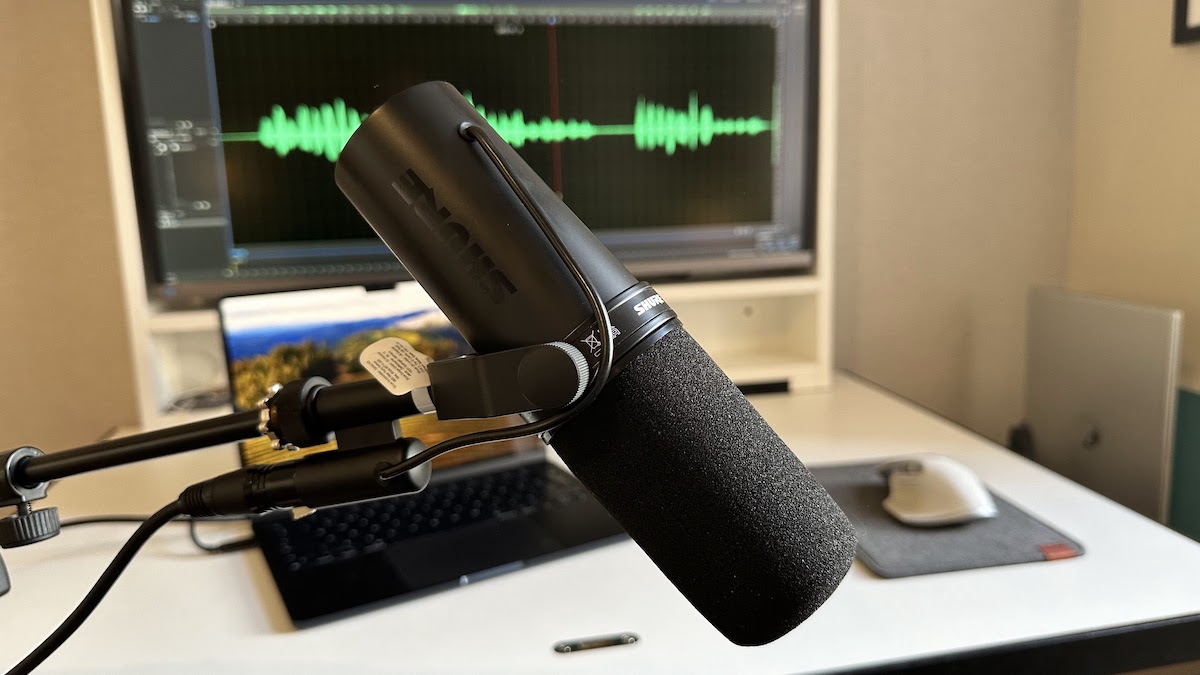
Shure SM7dB review: What is it?
If you’ve listened to a podcast over the last 10 years, then you’ll likely have heard the work of the Shure SM7B, which has become the go-to speech microphone of its era. Building on the legacy of the SM7B, the SM7dB, which we’re looking at today, aims to increase its capabilities by introducing a built-in preamp, offering up to +28dB of gain, making it, in theory, more usable across a variety of different applications.
The SM7dB aims to simplify the recording process by essentially eliminating the need for external preamps. This feature is particularly beneficial for users with audio interfaces that lack sufficient gain, as it ensures optimal sound levels without additional (or more expensive) equipment. Less background hiss at higher levels, and a much cleaner sound available for recording or streaming as a result. Simple.
Very little else has changed; the SM7dB’s cardioid polar pattern still effectively isolates the sound source, minimising background noise and making it ideal for home studios and professional recording environments alike. The SM7dB also retains the iconic design - other than a slightly stealthier-looking appearance - and sound signature of its predecessor, ensuring the same warm, smooth audio quality that has made the SM7B a staple in studios worldwide.
Whether you're a podcaster looking to enhance the clarity of your voice, a streamer aiming for professional-grade audio, or a musician seeking a reliable microphone for studio recordings, the Shure SM7dB offers a user-friendly and high-quality solution. But how does it work in the real world? Is the addition of a hefty preamp enough to tempt you into upgrading from your original SM7B? Let’s take a look.
Shure SM7dB review: Performance & verdict

Design and build quality
The Shure SM7dB maintains the iconic design of its predecessors with a sleek, matte black finish and rugged construction that - after years of using an SM7B - we’d have no problems recommending. As a dynamic mic, it’s already inherently more robust than a typical condenser, and its rugged exterior gives us extra cause for confidence. Weighing approximately 837g, it still feels substantial in the hand and well-built, ensuring longevity even under rigorous use. The SM7dB also includes a detachable windscreen, which helps reduce plosive sounds and unwanted noise, and did a great job in my testing studio of keeping those nasty pops to a minimum.
Features and connectivity
One of the standout features of the SM7dB is its built-in preamp, which provides up to +28dB of gain. This eliminates the need for external preamps, making it a convenient option for users with interfaces that may lack sufficient gain. It does, however, require +48V phantom power to operate the built-in preamp, but this is standard in most modern audio interfaces so shouldn’t be a cause for concern. The preamp can also be bypassed if you need it to, allowing users to revert to the original SM7B settings, or if you can’t get a 48V signal to it.
Overall performance
The SM7dB genuinely excels in delivering clear, natural sound across a wide frequency range (50 to 20,000 Hz). For speech applications, like podcasts or streaming, there aren’t many that compare when it comes to unlocking that rich, velvety broadcast sound you hear from the professionals. Its cardioid polar pattern performs well at isolating the sound source, minimizing background noise and making it great for less-than-ideal recording spaces.
The microphone’s performance is further enhanced by features like bass roll-off and presence boost, which allow users to tailor the frequency response to suit different recording needs - sometimes nice to head things off at source if you can, rather than fixing everything in post, and these extra controls were welcomed.

Comparison with similar microphones
Compared to other dynamic microphones like the Sennheiser MD 421-II and the Rode Procaster, the SM7dB stands out for its integrated preamp, which simplifies the recording setup by providing sufficient gain without additional equipment. The Sennheiser MD 421-II is known for its versatility and excellent sound reproduction, particularly for instruments, but it lacks the built-in gain boost of the SM7dB.
Likewise, the Rode Procaster, while offering robust build quality and good sound isolation, also does not include a built-in preamp, making the Shure SM7dB a more convenient option for those seeking an all-in-one solution.
Realistically, you’re either looking at a higher-end audio interface or even dedicated mic preamps as your main alternatives here.
Comparison with the Shure SM7B
The elephant in the room comes with the comparison to the original SM7B. Clearly, the primary advantage of the SM7dB over the SM7B is the integrated preamp, which addresses one of the main limitations of the SM7B - its need for a high-gain external preamp to achieve optimal sound levels. This makes the SM7dB more user-friendly and accessible, particularly for podcasters and streamers who may not have access to high-end audio interfaces. The sound signature of the SM7dB remains faithful to the SM7B, ensuring the warm, smooth audio quality that users have come to expect from Shure, so while it is a new model, it’s an evolution rather than a revolution.
Conclusion
The Shure SM7dB is a worthy successor to the SM7B, offering all the benefits of its predecessor with the added convenience of an integrated preamp. Its robust design, excellent sound isolation, and versatile features make it a top choice for professionals in various audio fields. While slightly more expensive, the built-in gain control and ease of setup justify the investment for those seeking high-quality, hassle-free recording solutions. Whether you're upgrading from the SM7B or exploring professional microphones for the first time, the SM7dB is a compelling option that stands out in its category.
Shure SM7dB review: Hands-on demos
Podcastage
Sean Divine
Senpai Gaming
Shure SM7dB review: Specification
- Type: Dynamic
- Frequency range: 20Hz to 20kHz
- Polar pattern: Cardioid
- Connectivity: XLR
- Boost: +18dB or +28dB
- Controls: Bass rolloff or mid-range emphasis
- Contact: Shure







